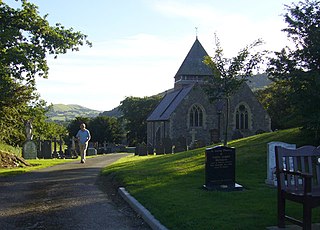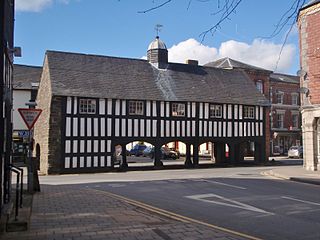Decline and destruction (1882–1912)
Later the Newtown woollen industry again went into decline. The Welsh Woollen Manufacturing Company had over-extended itself and went bankrupt in 1882, and the Severn Tweed Company acquired the Cambrian Mill. There was no local coal to power the machinery, and importing coal added to costs. Also, there was no direct railway to carry the flannels to the South Wales Coalfield, where they would have been in demand. Instead, they had to be shipped to northern England, where there was intense competition from local mills. The Pryce-Jones "Welsh" flannel was eventually mostly made in Rochdale, Lancashire.
The steam engines were very inefficient and used 8 pounds (3.6 kg) of slack coal per horsepower/hour. At the start of 1891 the Severn Tweed Company replaced them with much more cost-effective gas motors. However, by the end of the 19th century the mills in Newton were no longer competitive with those in the north of England. There was a disastrous fire in 1910, and another in 1912, after which the mill was not rebuilt. After the Cambrian Mills closed, Newtown was no longer an important woollen industrial centre and many of the workers moved elsewhere. Price-Jones's company remained profitable until the Great Depression. It was sold to a firm in Liverpool in 1938. The site today is the Cambrian Gardens district of Newtown.

Powys is a principal area and county, and one of the preserved counties of Wales. It is named after the Kingdom of Powys which was a Welsh successor state, petty kingdom and principality that emerged during the Middle Ages following the end of Roman rule in Britain.

Montgomeryshire, also known as Maldwyn is one of thirteen historic counties and a former administrative county of Wales. It is named after its county town, Montgomery, which in turn is named after one of William the Conqueror's main counsellors, Roger de Montgomerie, who was the 1st Earl of Shrewsbury.

Welshpool is a market town and community in Wales, historically in the county of Montgomeryshire, but currently administered as part of the unitary authority of Powys. The town is situated 4 miles (6.4 km) from the Wales–England border and low-lying on the River Severn; its Welsh language name Y Trallwng means "the marshy or sinking land". The community includes Cloddiau and Pool Quay.

Newtown, the largest town in the county of Powys, Mid Wales, lies on the River Severn in the community of Newtown and Llanllwchaiarn, within the historic boundaries of Montgomeryshire. It was designated a new town in 1967 and saw population growth as firms settled, changing its market-town character. Its 2001 population of 10,780 rose to 11,357 at the 2011 census. It was the birthplace of Robert Owen in 1771, whose house stood on the present site of the HSBC Bank. The town has a theatre, Theatr Hafren, and a public gallery, Oriel Davies, displaying contemporary arts and crafts.

Llanidloes is a town and community on the A470 and B4518 roads in Powys, within the historic county boundaries of Montgomeryshire, Wales. The population in 2011 was 2,929, of whom 15% could speak Welsh. It is the third largest settlement in Montgomeryshire, after Newtown and Welshpool.

Caersws is a village and community on the River Severn, in the Welsh county of Powys (Montgomeryshire) 5 miles (8 km) west of Newtown, and halfway between Aberystwyth and Shrewsbury. It has a station on the Cambrian Line from Aberystwyth to Shrewsbury. At the 2001 census it had a population of 1,526, increasing slightly to 1,586 at the 2011 Census.
Mid Wales is the central region of Wales. The Mid Wales Regional Committee of the Senedd covered the unitary authority areas of Ceredigion and Powys and the area of Gwynedd that had previously been the district of Meirionnydd. A similar definition is used by the BBC. The Wales Spatial Plan defines a region known as "Central Wales" which covers Ceredigion and Powys. If Mid Wales is classed as Ceredigion and Powys, the area would be 6,962 square kilometres (2,688 sq mi).

Flannel is a soft woven fabric, of various fineness. Flannel was originally made from carded wool or worsted yarn, but is now often made from either wool, cotton, or synthetic fiber.

Llandinam is a village and community in Montgomeryshire, Powys, central Wales, between Newtown and Llanidloes, located on the A470. As a community, Llandinam is made up of the village itself, small hamlets including Plas Dinam and Little London and several farms. The village itself has a population of around 576 with 56% born in Wales.

Abermule is a village lying on the River Severn 6 km northeast of Newtown in Powys, mid Wales. The A483 Swansea to Chester trunk road, the Cambrian Line railway, connecting Aberystwyth to Shrewsbury, and the Montgomery Canal, close to the river, all pass through Abermule. The village had a population of 900 as of the 2011 census.

Sir Pryce Pryce-Jones was a Welsh entrepreneur who formed the first mail order business, revolutionising how products were sold. Creating the first mail order catalogues – which consisted of woollen goods – for the first time customers could order by post, and the goods were delivered by railway.

Newtown railway station is a railway station serving Newtown in Powys, Wales.

Llanidloes railway station is a former junction railway station in Llanidloes, Powys, Wales. The Cambrian Railways, which completed the building in 1864, designed it to be both the station for the town and its company headquarters. This dual purpose gave Llandiloes station an imposing appearance.

The Mid-Wales Railway was a railway company intended to make a trunk route through Wales, connecting industrial areas of north west England with sea ports in south west Wales. In fact it was prevented from reaching its goal by competing proposals in Parliament, and it was limited to a line between Llanidloes and a junction with the Brecon and Merthyr Railway 5 miles (8 km) east of Brecon. It was 70 miles (110 km) in length and opened in 1864. It had found it impossible to raise share subscription, but the contractor partnership of Davies and Savin agreed to build the line and take shares in payment,
The Oswestry and Newtown Railway was a British railway company that built a line between Oswestry in Shropshire and Newtown Montgomeryshire, now Powys. The line opened in stages in 1860 and 1861. It was conceived to open up the area to rail transport, when local opinion formed the view that the trunk railway companies would not do so. Subscription money for the construction proved very difficult to generate. It was the action of a contractor partnership, Davies and Savin, in agreeing to accept shares as the majority of their payment for construction work, that saved the company from failure.

The Newtown and Machynlleth Railway was a railway company in Wales. It built a line from a junction with the Llanidloes and Newtown Railway near Caersws to the market town of Machynlleth; the line opened in 1862. Newtown had become the hub of railway lines in the district. Machynlleth was an important town, and extension from there to Aberystwyth and to the coast northward was in the minds of the promoters.

The woollen industry in Wales was at times the country's most important industry, though it often struggled to compete with the better-funded woollen mills in the north of England, and almost disappeared during the 20th century. There is continued demand for quality Welsh woollen products.

Solva Woollen Mill is a woollen mill in the village of Middle Mill, about one mile from Solva, Pembrokeshire, Wales, that has been in operation since 1907.

Cambrian Woollen Mill, just north of Llanwrtyd Wells, Powys, is one of the few remaining operational woollen mills in Wales. It is known for its line of Welsh tartans. The building dates to 1820.

The Old Market Hall is the oldest timber-framed market hall in Llanidloes, Wales, dating to the early 17th century. Until well into the 20th century a weekly market was held on the open cobbled ground floor. Over the years the large and well-lit upper floor room has been used as a wool and flannel market, law court, preachers' hall, flannel store, working men's institute and museum.



















